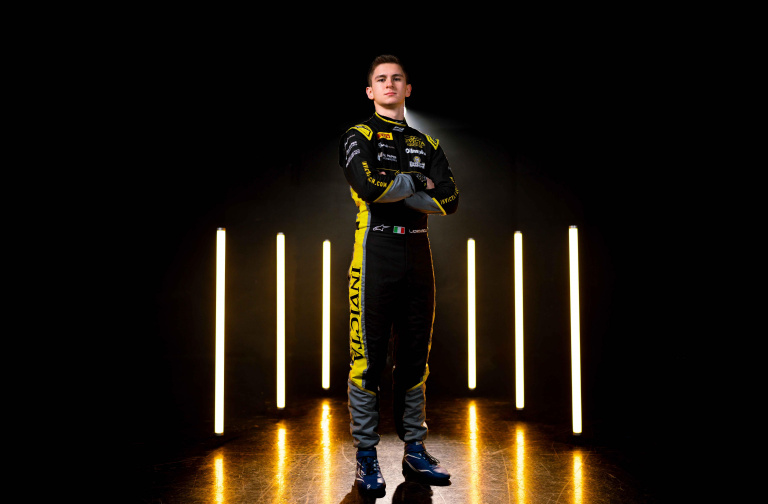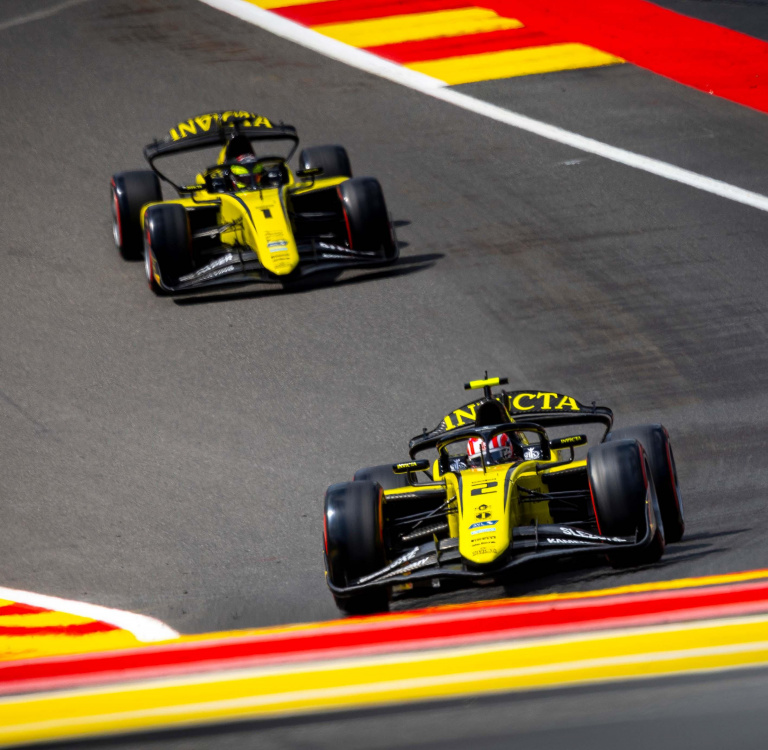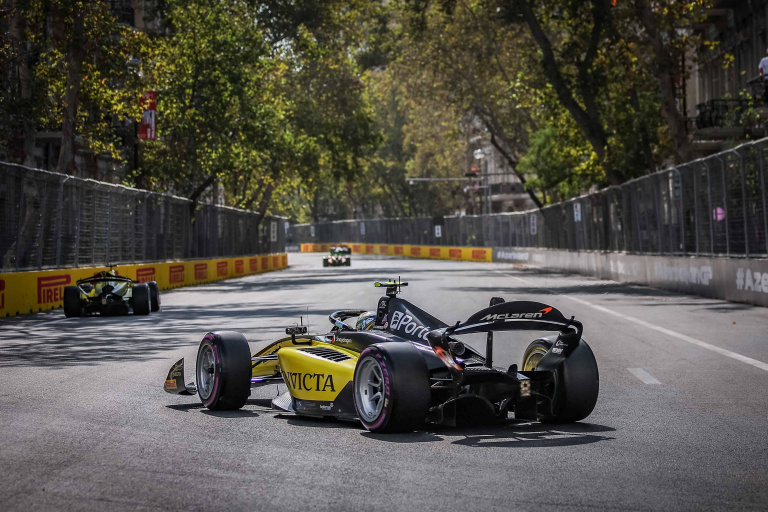Formula 2 is the official feeder series for Formula 1, providing a crucial platform for the next generation of drivers to refine the technical, physical and strategic skills required to compete at the pinnacle of motorsport.
Whether you're new to motorsport or a dedicated fan, this guide will answer all your questions about the FIA Formula 2 Championship, the differences between F1 and F2 and what to expect in the 2025 season.
What is Formula 2?
Established in 2017, the FIA Formula 2 Championship bridges the gap between junior motorsports categories and F1 while also serving as a rigorous testing ground for emerging talent, with a number of F2 graduates securing seats in F1.
Racing for 11 different teams, 22 of the world’s most talented young drivers come together to race in F2.
Invicta Racing will enter the 2025 Formula 2 Championship as the reigning Teams' Champions with two exciting new drivers.
Key differences between F1 and F2
Although both F1 and F2 race at some of the same iconic circuits, the two series have several key differences:
Car specifications
· Unlike F1, F2 is a single-make championship, meaning all cars are the same. By providing all drivers with the same car, F2 places the spotlight on driver talent.
· Though they’re slower than F1 cars, cars in the FIA Formula 2 Championship are faster than many other racing cars, hitting speeds of up to 200mph.
· F2 cars are only slightly lighter than F1 cars, weighing in at roughly 795kg.
Aerodynamics
· F1 cars create significant levels of downforce. F2 cars feature a much simpler aerodynamic design, resulting in less stability and relying more on driver skill to control them.
Race format
· Both F1 and F2 race weekends span three days, but F2 has a slightly different format, with Sprint and Feature Races every weekend.
· F1 and F2 host their main races at the same track on the same day. F2 Feature Races typically take place earlier in the day than F1 Grands Prix and are much shorter in comparison.
· While F2 has fewer rounds than F1, they both feature a similar number of races; in 2025, F1 consists of 24 rounds and 30 races (including six Sprints), while F2 features 14 rounds and 28 races.
How does an F2 race weekend work?
An F2 race weekend follows a similar format to F1’s Sprint weekends, with some differences.
Friday
· The first session of the weekend is a 45-minute Free Practice for drivers and teams to get up to speed with the circuit and gather as much information as possible.
· Qualifying follows Free Practice, allowing 30 minutes for the drivers to set the grid for the weekend’s races.
Saturday
· The Sprint Race covers 120 kilometres (or 45 minutes), with the starting grid being determined by inverting the top ten finishers of Friday’s Qualifying.
Sunday
· The 170-kilometre Feature Race takes place prior to the F1 Grand Prix. Unlike the Sprint Race, the Feature Race includes a mandatory pitstop, and the starting grid is determined by the final classification of Friday’s Qualifying.
Who’ll be racing for Invicta in 2025?
Invicta Racing is gearing up for an exciting 2025 season with two talented drivers:
· Leonardo Fornaroli: After securing the 2024 FIA Formula 3 title with a thrilling last-lap, last-corner overtake, Leonardo will make his debut in Formula 2. With ten podium finishes in F3, he aims to carry that momentum into F2.
· Roman Stanek: Returning for his third F2 season, Roman joins Invicta for 2025. Having already claimed a victory in the 2024 Melbourne Sprint Race, he’s eager to continue his success.
How do drivers progress from F2 to F1?
The purpose of F2 is to offer young drivers the tools they need to access F1 and the opportunity to develop their skills, refine their racecraft, and gain valuable experience. Many of the competitors are part of the young driver programmes offered by F1 teams, so if you’re fighting for the top spots, the route into the top category isn’t far away.
From the 2024 F2 grid, five drivers will be taking to the track for the 2025 F1 season, including Invicta Racing alumni Gabriel Bortoleto who joins Sauber following his Drivers’ and Teams’ Championship victory with Invicta in 2024 as well as Jack Doohan at Alpine.
READ MORE: Invicta Racing’s F1 graduates
Where does F2 race?
The 2025 season will feature 14 rounds spanning three continents, all taking place on F1 race weekends.
Starting in Australia and concluding in Abu Dhabi, the season will feature a mix of iconic circuits such as Silverstone, Monaco and Spa-Francorchamps with plenty of modern tracks in the mix as well.
How are points scored in F2?
There are several ways to score points during an F2 race weekend, with a potential maximum score of 39 points.
Qualifying
· The first two points of the weekend are allocated on Friday, with 2 points awarded for pole position.
Sprint Race
· The top eight finishers of Saturday’s Sprint Race score 10, 8, 6, 5, 4, 3, 2 and 1 points respectively.
· An additional point is awarded to the driver with the fastest lap.
Feature Race
· The majority of points come from the Feature Race on Sunday, where 25, 18, 15, 12, 10, 8, 6, 4, 2 and 1 points are awarded to the top ten.
·A fastest lap point is also up for grabs in the Feature race.
In 2024, Invicta Racing secured 288.5 points, winning the Teams’ Championship.
What are the technical specifications of an F2 car?
F2 is a spec series, meaning all teams must use the same chassis, engine and tyre supplier. This emphasises driver skill and strategic acumen, providing an even playing field for emerging talent to showcase their ability regardless of team.
Chassis
· The chassis has been developed by Dallara, an Italian manufacturer, since 2024.
· Since Dallara joined F2, the chassis aligns with F1’s ground effect aerodynamics.
· The car measures 5285mm in length and 1900mm in width.
Engine
· 3.4L turbocharged V6 engines are supplied by Mecachrome.
· The engine runs on Aramco advanced sustainable fuel.
· Incorporating a fly-by-wire accelerator system, these engines produce 620 horsepower at 8750 rpm.
Tyres
· Pirelli have been the official tyre supplier since F2’s first season in 2017.
· The tyres feature 18” x 12” front wheels and 18” x 13.7” rear wheels.
· The dry compounds consist of purple supersoft, red soft, yellow medium, and white hard. The sole wet compound is the blue wet weather tyre.
Does F2 have DRS?
Like F1, drivers in F2 are able to use the Drag Reduction System (DRS).
DRS is available in designated zones during Free Practice and Qualifying, with these zones being the same ones used in F1. During the races, drivers can only activate DRS in the zones when they are within a second of the car in front.
How can I watch F2 races in 2025?
There are a number of viewing options available to ensure you catch all the action this season.


